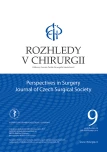Foreign body ingestion in children
Authors:
J. Lešková; R. Štichhauer; J. Preis; A. Šafus; J. Koudelka
Authors place of work:
Centrum dětské traumatologie Fakultní nemocnice Hradec Králové, Lékařská fakulta Hradec Králové
; Oddělení dětské chirurgie a traumatologie Fakultní nemocnice Hradec Králové
Published in the journal:
Rozhl. Chir., 2019, roč. 98, č. 9, s. 370-374.
Category:
Původní práce
doi:
https://doi.org/10.33699/PIS.2019.98.9.370–374
Summary
Introduction: Evaluation of results of the group of paediatric patients treated for swallowed foreign bodies in the digestive tract.
Methods: Retrospective analysis of patients treated for foreign bodies in the digestive tract, managed at the University Hospital of Hradec Králové between 2011–2018.
Results: 365 patients (182 boys, 183 girls) with a foreign body in the digestive tract have been evaluated. The mean age was 2.4 years. Most of the children were treated as outpatients (280 children, 76.7%) and only 85 children (23.3%) were hospitalized.
The most commonly swallowed frequent bodies included coins (26%) and batteries (14.5%); sharp objects occurred in 5.2%. Unusual foreign bodies were noticed, too. We can mention for example a pen or a plant nutrition product. In 302 cases (82.7%) the foreign bodies passed easily per vias naturales. Endoscopy was necessary in 63 cases (17.2%) – in 51 children the object had to be removed from the oesophagus and in 12 children the object had to be removed from the stomach. None of the swallowed bodies caused complications such as digestive tract perforation or bowel obstruction. No patient in the group was indicated for laparotomy to remove the foreign body.
Conclusion: Foreign bodies entrapped in the oesophagus have to be removed endoscopically. In most cases, foreign bodies in the stomach require only observation in the outpatient setting because they leave the stomach easily, without complications, per vias naturales. If a battery remains at the same place of the digestive tract for more than 24 hours, endoscopic removal is indicated at our department. In addition, endoscopy is done in cases of swallowed multiple magnets or bodies that are too large and remain in stomach for several weeks or months. Surgical removal of foreign bodies should be reserved only for complicated cases.
Keywords:
endoscopy – body mass index – foreign bodies – digestive tract
Zdroje
- Holcomb GW, Murphy JP, Ostlie DJ. Ashcraft´s pediatric surgery. Sixth edition. Elsevier Sunders 2014;147−54.
- Nevoral J, et al. Praktická pediatrická gastroenterologie, hepatologie a výživa. Mladá fronta, Praha 2013; 86−95.
- Sign N, Chong J, Ho J, et al. Predictive factors associated with spontaneous passage of coins: A ten-year analysis of paediatric coin ingestion in Australia. Int J Pediatr Otorhinolaryngol. 2018;113:266−71. doi: 10.1016/j.ijporl.2018.08.010.
- Krom H, Visser M, Hulst JM, et al. Serious complications after button battery ingestion in children. Eur J Pediatr. 2018;177:1063−70. doi:10.1007/s00431-018-3154-6.
- Macchini F, Vestri E, Ichino M, et al. Button battery ingestion in children: A specific clinical issue. Clin Endosc. 2018;51:602−3. doi:10.5946/ce.2018.137.
- Sindi E, Bahadur A, AIRajhi H, et al. Yousef Y. Disc battery ingestion; a single event with different outcomes. Int J Pediatr Adolesc Med. 2017;4:87−90. doi:10.1016/j.ijpam.2017.04.003.
- Cho J, Sung K, Lee D. Magnetic foreign body ingestion in pediatric patients: report of three cases. BMC Surg. 2017;17:73. doi: 10.1186/s12893-017-0269-z.
- Zachos K, Panagidis A, Georgiou G, et al. Double jejunoileal fistula after ingestion of magnets. J Indian Assoc Pediatr Surg. 2019;24:63−4. doi:10.4103/jiaps.JIAPS-92-18.
- Povolný J. Lékařský teploměr v trávicím traktu dítěte. Rozhl Chir. 1978;57:597−8.
- Lee JH, Lee JH, Shim JO, et al. Foreign body ingestion in children: should button baterries in the stomach be urgently removed? Pediatr Gastroenterol Hepatol Nutr. 2016;19:20-8. doi:10.5223/pghn.2016.19.1.20.
- Kramer RE, Lerner DG, Lin T, et al. Management of ingestion foreign bodies in children: A clinical report of the NASPGHAN Endoscopy Committee. JPGN 2015;60:562−74.
- Vospělová J, Procházka V, Tenora J, et al. Cizí tělesa v horním zažívacím traktu u dětí. Kdy indikovat endoskopickou extrakci? Pediatr pro praxi 2006;5:281−3.
- Chen LH, Zhang X, Li SQ, et al. The risk factors for hypoxemia in children younger than 5 years old undergoing rigid bronchoscopy for foreign body removal. Anesth Analg. 2009;109:1079−84. doi:10.1213/ane.0b013e3181b12cb5.
- Park YK, Kim KO, Yang JH, et al. Factors associated with development of complications after endoscopic foreign body removal. Saudi J Gastroenterol. 2013;19:230−4. doi:10.4103/1319-3767. 118136.
- Koudelka J. Spolknutá cizí tělesa v dětském věku. Praktický lékař 1999;79:49−51.
Štítky
Chirurgie všeobecná Ortopedie Urgentní medicínaČlánek vyšel v časopise
Rozhledy v chirurgii

2019 Číslo 9
- Metamizol jako analgetikum první volby: kdy, pro koho, jak a proč?
- Specifika v komunikaci s pacienty s ránou – laická doporučení
- MUDr. Lenka Klimešová: Multioborová vizita může být klíčem k efektivnější perioperační léčbě chronické bolesti
Nejčtenější v tomto čísle
- Cizí tělesa v GIT u dětí
- Fyloidné nádory prsníka – retrospektívny prehľad 83 klinických prípadov
- ERAS v kolorektální chirurgii – opomíjená přednemocniční část
- Perkutánní endoskopická cékostomie v léčbě rekurentní střevní pseudoobstrukce − popis prvního výkonu v České republice
